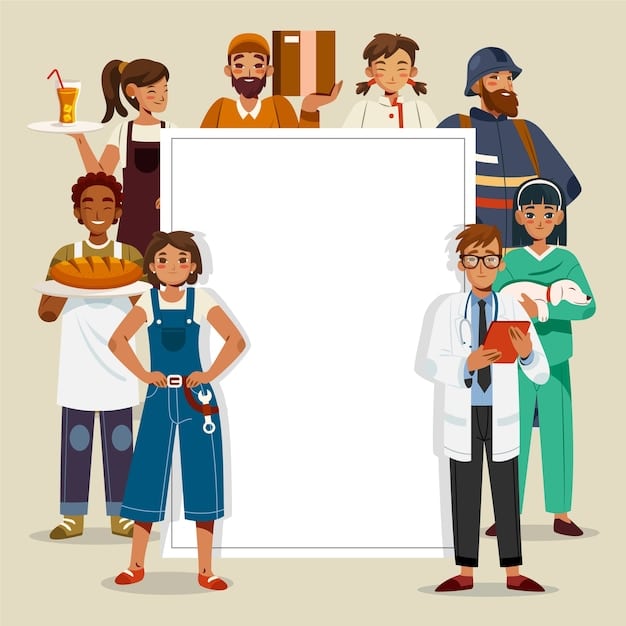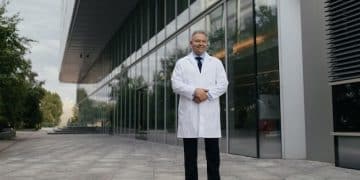5 Student Loan Forgiveness Programs You Need to Know Before 2026

Several lesser-known student loan forgiveness programs can provide significant relief before January 2026, offering pathways to debt cancellation based on specific employment, volunteer work, or unique circumstances. These include programs like Teacher Loan Forgiveness, Public Service Loan Forgiveness (PSLF), and others tailored to certain professions or situations, often with specific eligibility criteria and application deadlines.
Navigating the world of student loans can feel overwhelming, especially with so many repayment options and forgiveness programs available. While you’ve likely heard of the most common programs, there are several lesser-known opportunities that could provide significant debt relief. Here are 5 little-known student loan forgiveness programs you need to apply for before January 2026.
Unveiling the Teacher Loan Forgiveness Program
Many educators burdened with student loan debt are unaware of the Teacher Loan Forgiveness program. This initiative aims to alleviate the financial strain on teachers who dedicate their careers to serving low-income communities.
The Teacher Loan Forgiveness Program offers forgiveness of up to $17,500 on Direct Subsidized and Unsubsidized Loans and Subsidized and Unsubsidized Federal Stafford Loans. To qualify, you must be a highly qualified full-time teacher for five complete and consecutive academic years in a low-income elementary or secondary school or educational service agency. The specifics of this program can be intricate, but the benefits are substantial for eligible teachers.
Eligibility Requirements
To be eligible for the Teacher Loan Forgiveness Program, you must meet specific criteria. These include holding a valid teaching certificate, working full-time at a qualifying low-income school, and having outstanding eligible student loan debt. Carefully reviewing these requirements is crucial to ensure you meet all the necessary conditions.
- Must have been employed as a full-time teacher for five complete and consecutive academic years.
- At least one of those years must have been after the 1997-1998 academic year.
- Loans must have been made before the end of your five academic years of qualifying teaching service.
- The loan cannot have been used to obtain a degree in teaching.
This program can be a lifeline for teachers struggling with student loan debt, providing significant financial relief and encouraging them to continue their important work in underserved communities.

Exploring the Public Service Loan Forgiveness (PSLF) Program
The Public Service Loan Forgiveness (PSLF) program is a beacon of hope for individuals employed in public service. This program offers the potential for student loan forgiveness after making 120 qualifying monthly payments while working full-time for a qualifying employer.
The PSLF program applies to various professions, including government employees, non-profit workers, and those in public health or education. The eligibility criteria and application process can seem complex, but understanding the requirements can lead to significant debt relief for those dedicated to public service.
Qualifying Employment
To qualify for PSLF, your employment must be with a qualifying employer. This typically includes government organizations at any level (federal, state, local, or tribal) and non-profit organizations that are tax-exempt under Section 501(c)(3) of the Internal Revenue Code. Certain other types of non-profit organizations may also qualify.
Qualifying Payments
Making 120 qualifying monthly payments is a key requirement for PSLF. These payments must be made under a qualifying repayment plan, such as an income-driven repayment plan. It’s essential to ensure your payments are made on time and meet all the necessary criteria.
- Must work full-time for a qualifying employer while making the 120 qualifying payments.
- Payments must be made under an income-driven repayment plan.
- Must submit the PSLF application and Employment Certification Form to confirm eligibility.
The PSLF program provides a significant opportunity for public servants to alleviate their student loan debt, recognizing their dedication to serving the community.
Understanding the Perkins Loan Cancellation Program
The Federal Perkins Loan Program once offered low-interest loans to students with exceptional financial need. While the program is no longer issuing new loans, those who previously received Perkins Loans may be eligible for loan cancellation based on certain employment or volunteer service.
Perkins Loan Cancellation is available for individuals in specific professions, such as teachers, nurses, law enforcement officers, and those serving in the military. The amount of loan cancellation varies depending on the profession and the length of service, but it can provide substantial debt relief for eligible borrowers.
Eligible Professions
Several professions qualify for Perkins Loan Cancellation. These include teachers who teach in designated low-income schools or teach specific subjects (such as special education), nurses, medical technicians, law enforcement officers, firefighters, and those serving in the military. The specific eligibility requirements vary depending on the profession.
This program can be a valuable resource for those who dedicated themselves to specific fields, acknowledging the contribution of people who pursue helping professions.

The National Health Service Corps Loan Repayment Program
Healthcare professionals committed to serving underserved communities may be eligible for the National Health Service Corps (NHSC) Loan Repayment Program. This program offers loan repayment assistance to primary care medical, dental, and mental health providers who agree to work in Health Professional Shortage Areas (HPSAs).
The NHSC Loan Repayment Program provides significant financial assistance to healthcare providers, incentivizing them to practice in communities where access to healthcare is limited. In exchange for a service commitment, eligible providers can receive loan repayment assistance to alleviate their student loan debt.
Service Commitment
To participate in the NHSC Loan Repayment Program, healthcare providers must commit to working full-time or part-time at an NHSC-approved site located in a Health Professional Shortage Area (HPSA). The length of the service commitment varies depending on the amount of loan repayment assistance received.
The NHSC Loan Repayment Program plays a vital role in ensuring access to quality healthcare in underserved communities while providing financial relief to dedicated healthcare professionals.
Investigating Income-Driven Repayment (IDR) Forgiveness
Income-Driven Repayment (IDR) plans offer a path to student loan forgiveness after a specified period of repayment. These plans base your monthly payment on your income and family size, making repayment more affordable. After 20 or 25 years of qualifying payments, the remaining balance of your loan may be forgiven.
IDR forgiveness is available for borrowers with federal student loans. Several IDR plans exist, including Income-Based Repayment (IBR), Pay As You Earn (PAYE), and Saving on a Valuable Education (SAVE). The specific terms and conditions of each plan vary, so it’s important to choose the plan that best fits your individual circumstances.
Qualifying Payments Under IDR
To qualify for IDR forgiveness, you must make a specified number of qualifying payments under an IDR plan. The number of payments required varies depending on the plan, but it’s typically 20 or 25 years (240 or 300 months). It’s essential to ensure your payments are made on time and meet all the necessary criteria.
- Payments must be made under a qualifying IDR plan.
- Must recertify your income and family size annually.
- Forgiven amount may be subject to income tax.
IDR forgiveness provides a safety net for borrowers who struggle to repay their student loans, offering the potential for debt cancellation after a prolonged period of repayment.
| Key Point | Brief Description |
|---|---|
| 👩🏫 Teacher Loan Forgiveness | Forgives up to $17,500 for eligible teachers in low-income schools. |
| 🧑⚕️ Public Service Loan Forgiveness | Forgives loans after 120 qualifying payments while working in public service. |
| 🩺 National Health Service Corps | Offers loan repayment to healthcare providers in underserved areas. |
| 💸 Income-Driven Repayment (IDR) | Forgives remaining balance after 20-25 years of qualifying payments. |
Frequently Asked Questions (FAQ)
▼
While some programs have ongoing enrollment, it’s crucial to apply before January 2026 to maximize your chances of eligibility and avoid potential changes to program requirements. Always check the specific program’s guidelines for exact deadlines.
▼
Qualifying employers typically include government organizations (federal, state, local, tribal) and non-profit organizations that are tax-exempt under Section 501(c)(3) of the Internal Revenue Code. The PSLF Employer Search tool on the Federal Student Aid website can help.
▼
It depends on the specific program and current tax laws. Generally, amounts forgiven under Income-Driven Repayment (IDR) plans may be considered taxable income, while amounts forgiven under PSLF are often tax-free. Consult a tax professional for personalized advice.
▼
In most cases, you cannot receive forgiveness under multiple programs for the same loan. Programs often require consolidating all eligible loans, which would make those loans ineligible for other forgiveness options. Explore carefully to decide what fits best.
▼
The official website for Federal Student Aid is the best source for detailed information, eligibility requirements, and application forms for all federal student loan forgiveness programs. Don’t forget to check program-specific websites for updates!
Conclusion
These 5 little-known student loan forgiveness programs you need to apply for before January 2026 can provide substantial debt relief for eligible borrowers. Remember to research each program thoroughly, understand the eligibility criteria, and apply before any critical deadlines. Take the first step towards a brighter financial future by exploring these options today.





